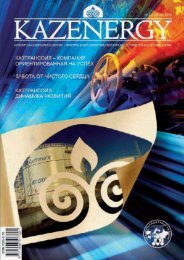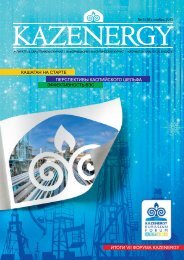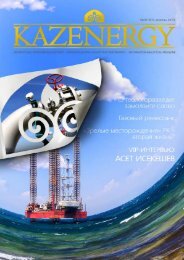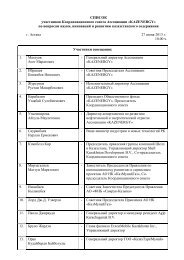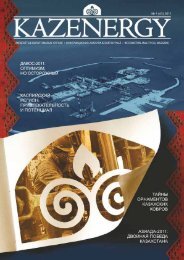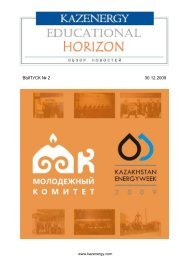â 5 (49), 2011 - KazEnergy
â 5 (49), 2011 - KazEnergy
â 5 (49), 2011 - KazEnergy
- No tags were found...
Create successful ePaper yourself
Turn your PDF publications into a flip-book with our unique Google optimized e-Paper software.
Now at KashaganPhase I preparationis going on, whichincludes receivingthe first commercialoil in late 2012.If at Kashagan everything will go accordingto plan, in 2012, a consortium will producealmost 0.57 million tons of oil. A year later,production will rise to 9.12 million, in 2014will rise to 13.24 million tonnes, in 2015 - upalmost to 15 million. Increase in productionwill provide two lines of work: drilling of newwells (13 in 2013-2014 years), and injectionof 50% of the extracted gas. While not as away to enhance oil recovery, but as a meansof disposal of hydrogen sulfide impuritiesthat impede commodity production of oil.At the same time year 2015 has to become alandmark for the development of Kashagan.Although the annual volume of productionduring his rise slightly, more than doublingof production well stock is planned- it willincrease to 67 units. And the end of 2015production levels will reach 450 thousandbarrels / day, which marks the realizationof fisheries, commercial and technologicalobjectives of Phase I. The way they will beresolved at this stage, will largely determinethe future course of development of Kashagan.And also becomes a kind of "masterclass", which Kashagan operator will holdfor members of other marine projects.Kashagan is paving the way. The secondhalf of this decade looks qualitatively as anew stage for development of Kashagan, andto develop the oil resources of Kazakhstan'ssector of Caspian Sea. If Phase II will be implementedaccording to plan (see «Partnersare discussing the price»), then from 2016 to2020 oil production at the field will increasefrom 28 million tonnes to nearly 60 million,which requres 75 wells to be drilled. In thelonger term, i.e. over the next decade, theshareholders will build 93 more wells, andwill raise annual production to 75 milliontonnesStarting from 2016, the development willinclude the new fields of Kazakhstan shelf- first Kairan, in 2018 - Aktoty and Kalamkas-sea(subsoil user for all - NCC), in2019 - Khazar, in 2020 - Auezov (a consortiumof EP, Shell, Oman Oil), Shell sea andH (Alliance KMG, ConocoPhillips and UAEMubadala Development Co.). In the nextdecade may other marine projects in Astana,including those agreements which weresigned this spring - "Abay", and "Satpayev,may enter into the production stage.But it is likely that marine subsoil users inKazakhstan, building their business models,will scrutinize not only the productionexperience of NCC at Kashagan, but alsosales policy and the consortium as a guidewhen choosing their own export routes. Representativesof the NCC previously statedthat for Phase I they believe in the priorityof the North-Caspian pipeline (better knownas CPC) and Atyrau - Samara. The first onestarts phased expansion of capacity from28 million this year to 67 million tonnes in2015, the second can at any time to increasepumping from 15 million to 17.5 million tonsper year.However, the interesting thing is that theconsortium (reported by sources close to it),also began to study options for export bypipeline Kazakhstan - China, whose capacityafter 2013 will double to 20 million tons;and of the Kazakh Caspian oil transportationsystem required after the start of PhaseII.Certainly, export "pressure" of Kashaganoil greatly help the progress of new pipelineprojects in various areas of Astana. And thuspave the transport routes for the next waveof marine operators. Kashagan "pioneer" onthe shelf will be a guide for them in the exportof Caspian hydrocarbonsKAZENERGY67







